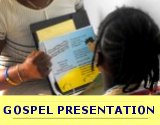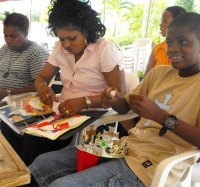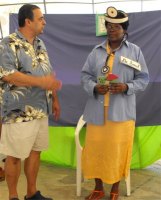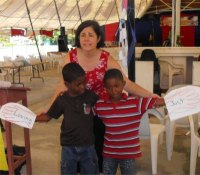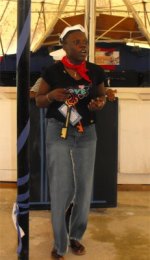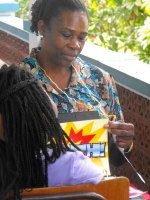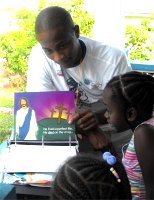|
Kids' EE is a fourteen unit curriculum. Units can
be taught in one or two lessons, depending on time allotted.
The Fourteen Units include:
Unit One: Scripture Fun Fair
Unit Two: Kids' EE Interview
Unit Three: Bare Bones Outline
Unit Four: Gospel in a Nutshell
Unit Five: Making a Commitment
Unit Six: Talking and Testimony
Unit Seven: Two Diagnostic Questions
Unit Eight: Grace (Heaven)
Unit Nine: Man
Unit Ten: God
Unit Eleven: Christ
Unit Twelve: Faith
Unit Thirteen: Commitment
Unit Fourteen: Follow-up
The Basic Elements of Kids' EE Training
Resources to Download
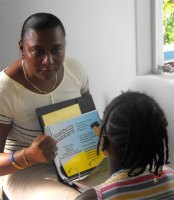 | Like
Adult and Youth EE, Kids' EE teaches a clear presentation
of the Gospel. Like these ministries, Kids' EE also provides
opportunities to practice sharing the Gospel in what are called
"On-the-Job Training" sessions.
Seen here one of the Barbados team at
a School Summer Camp |
Other elements of the Kids' EE training include interactive
instruction in large groups, building relationships with a team
leader and members of a team, and praying together in teams and
with prayer partners. Unlike Adult and Youth EE, Kids' EE does not
require homework nor does it use a lecture format for instruction.
Gospel Presentation:
The Kids' EE Gospel Presentation includes a basic outline, sub-points,
scripture verses, illustrations and transitional sentences. The
wording is in keeping with the simpler style of the Kids' EE Gospel
Presentation. In nations overseas, this presentation is being culturally
adapted to most effectively train children in the nations that have
begun training children to share the Gospel.
On-the-Job Training (OJT):
Providing the children with practice in sharing the Gospel is referred
to as "On-the-Job Training." The goal is to encourage
children to make sharing the Gospel with others a way of life. OJT
gives them the experiences that help to develop skills in sharing
the Good News with others so that children look for opportunities
to do so.
OJT with children must be safe, structured, supervised.
It must also provide the children with successful experiences. In
line with recommended child protection policies, it is recommended
that teams consist of two adults and two or three children. Before
going out, the leaders are given clear and specific guidelines for
each On-the-Job Training session, including the destination, directions
and required time for return.
There are many contexts where children can share
the Gospel during OJT, such as church visitor follow-up visits,
visits to nursing homes and retirement facilities, and special church
activities for children. But before the children are asked to do
so, they see their team leaders model sharing the Gospel with others.
The phrase "Evangelism is better caught than taught" is
as true for kids as it is for adults. As they see their team leaders
model sharing the Gospel Presentation, the children's own confidence
and excitement to share with others grows. Before going out for
their first OJT, the children engage in practice and role-play sessions
in their Kids' EE classroom.
There are a number of ways On-the-Job Training
can be structured:
1. OJT can be held on Sunday afternoon. During these
times, teams can:
Visit church visitor families or children who have visited Sunday
School.
Visit nursing homes
Visit special needs children's facilities
2. OJT can follow a Saturday morning session of Kids' EE and teams
can:
Visit hospital children's wards
Go to malls and other locations where kids gather
such as parks or video arcades.
Visit nursing homes, special needs children's development
centres and other facilities
3. In some cases, Adult and Kids' EE can work together to provide
the Kids' with OJT experiences. Children can go with their parents
who are in Adult EE on their home visits. This is especially appropriate
when an adult team is planning on visiting a family with children.
In this way the children can assist in sharing the Gospel with the
entire family.
4. Arrangements can be made for the children in
Kids' EE to share the Gospel with younger children in Sunday School
or other contexts. Some Sunday School teachers arrange for children
to share the Gospel with any new child who is attending a Sunday
School class for the first time.
5. After the children have had some experience in sharing the Gospel,
a planned outreach event can be arranged. Children invite their
non-churched friends for a special children's ministry event. A
structured time can be planned for the children to share the Gospel
with their friends.
Team Leaders:
In Kids' EE, we refer to the adults or youth who are working with
the children as team leaders, rather then "trainers."
This is a significant difference between Kids' EE and Adult and
Youth EE. In Kids' EE we are not training trainers to train others
to be witnesses. Kids' EE seeks to lay a foundation for spiritual
maturity in children's lives and develop habits of Christian discipleship
by deepening their understanding of the truths of the Gospel, the
meaning of personal faith in Christ, and the responsibility we all
have to be witnesses for Him.
Nevertheless, the model of one trainer for two trainees
used in Adult and Youth EE provides a strong relational and mentoring
type of ministry. In Kids' EE this is an essential component and
one team leader for two children is ideal. The relationships built
between the team leaders and the children and the experiences that
the children have with their team leaders will be enduring.
Prayer Partners:
Developing habits of praying for the lost and those with whom they
want to share the Gospel is an integral part of the Kids' EE training
each week. In addition, children are encouraged to pray with their
parents. This provides a powerful support for the ministry. Team
leaders are also encouraged to have their own prayer partners who
will pray with them for their teams and for those who are being
reached during OJT times.
Commitment:
Some children at this age depend on their parents for their motivation
to start and continue attending Kids' EE. Other children already
have a great desire to receive training in sharing the Gospel. A
model ministry will have team leaders and parents willing to nurture
in children in their commitment to attend Kids' EE. Parents become
an extension of the teacher and the team leaders, giving extra encouragement
and support in learning the Gospel presentation.
Homework:
Unlike adults and teens, elementary and middle school children do
not "teach themselves" while doing assigned homework.
Homework at this age is simply practice in what has been taught
in class. The success of homework assignments is often dependent
on the time parents can give to following-up with their children.
Kids' EE does not rely on assignments outside of class for the children
to learn and master the EE presentation. Class time is used to provide
necessary practice and repetition. Children are encouraged to share
each week what they have learned during their Kids' EE session.
Time for children to talk about their experiences in sharing with
others is included in each class session.
Lecture:
Kids' EE methods of teaching do not rely on lecture. Teaching activities
during large group instructional time are kept short and move along
quickly. Kids are involved in physical activities, such as marching
cadences and the practice of the hand motions, which are learned
along with the Gospel presentation. Learning is hands-on and key
concepts are reinforced through the crafts and the skits. These
supplement and add to the understanding children gain from the verbal
presentation of material
Register
now
Training Material
|



